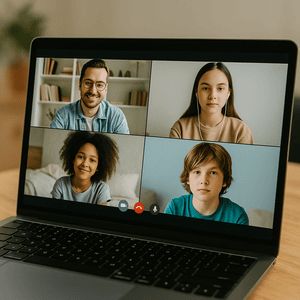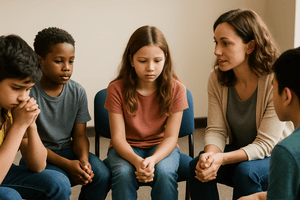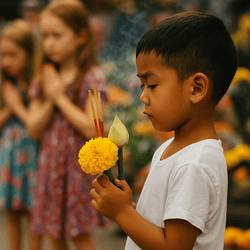Group Therapy for Grieving Children

Online Resources for Grieving Kids
July 12, 2025
Cultural Perspectives on Children and Grief
July 12, 2025Children often grieve quietly, yet deeply. Nearly 1 in 12 children in the U.S. will experience the death of a parent or sibling by age 18, according to Judi’s House/JAG Institute (2023 Childhood Bereavement Estimation Model). For many of them, talking to adults can feel overwhelming or even pointless when the words just won’t come. That’s where peer connection changes everything.
Group therapy offers a guided, age-appropriate space where grieving children don’t feel so alone. Unlike adult-led one-on-one sessions, group settings allow kids to see others navigating similar pain. They begin to talk, draw, ask questions, and express themselves more freely, often for the first time. With support from a trained facilitator, they learn to name their emotions and develop healthy coping skills in a setting that feels safe, familiar, and even hopeful.
In this article, you’ll learn what group therapy for grieving children really looks like, why it can be so effective, and how to find a local or virtual group that fits your child’s needs. Whether you’re a parent, caregiver, educator, or counselor, this guide will help you explore grief support that fosters healing through shared understanding.
What Is Group Therapy for Grieving Children?
Group therapy for grieving children is a structured form of emotional support where kids meet in small, age-matched groups to process their grief together. Unlike traditional one-on-one counseling, group sessions center around shared experiences, helping children understand that loss is not something they’re facing alone. Each group is guided by a trained facilitator who gently encourages conversation, creativity, and connection in a way that feels safe and manageable for young participants.
Therapist-Led, Age-Appropriate Sessions
Every group is led by a licensed grief counselor or therapist trained to work with children. Sessions are typically divided by age, such as early childhood (5–8), preteens (9–12), or teens (13–17), so that the activities, language, and emotional depth are suitable for where each child is developmentally. This separation is key, as younger children often benefit from storytelling and play, while older kids might prefer guided discussions or journaling.
Therapists use specific frameworks tailored to children’s cognitive and emotional levels. They guide kids through naming their feelings, learning how grief shows up in the body, and practicing coping techniques that feel natural and accessible. The structure isn’t rigid—but it’s intentional. Children are supported without pressure to participate in any one way.
Focus on Expression, Connection, and Coping Skills
Most group sessions involve a mix of open sharing and hands-on activities. Kids may:
- Draw pictures of their loved one or their feelings
- Write letters or stories
- Share memories in a group circle
- Participate in mindfulness exercises
- Create crafts like memory boxes or photo frames
These activities give children ways to express grief when words alone aren’t enough. As they see others participate, many begin to feel more confident opening up. Over time, they not only find comfort, they start building emotional tools that can serve them well beyond the group.
Types of Group Therapy Settings
Group therapy for grieving kids is available in several formats. The right fit often depends on location, access, and the child’s comfort level.
| Setting | Description | Best For |
| School-Based Grief Groups | Run during the school day by social workers or counselors. Typically meet weekly for a semester. | Children who feel more secure in familiar environments or have limited transportation access. |
| Community Programs | Hosted by churches, hospices, nonprofits, or community mental health centers. Often include themed workshops or seasonal series. | Families looking for consistent support outside of school and with potential for longer-term participation. |
| Online or Virtual Groups | Offered through grief centers or digital therapy platforms. Sessions are held on secure video calls with a counselor present. | Kids who live in rural areas, have mobility challenges, or feel more at ease in their own space. |
Each setting has its advantages, and many families explore more than one over time. What matters most is finding a group where the child feels safe, seen, and supported.
Unique Benefits of Group Therapy for Grieving Kids
While all grief support is valuable, group therapy offers something deeply specific to children: connection. For kids navigating loss, being in a room, virtual or in-person, with others who get it can shift the experience from isolation to understanding. It’s not just about talking; it’s about seeing, hearing, and feeling that they’re not alone.
Feeling Less Alone
Grieving children often feel different from their peers. They might withdraw, stop talking about the person they lost, or believe no one understands what they’re going through. In a group setting, that silence breaks. Hearing another child say, “I miss my dad too,” or “I get sad at night too,” instantly softens the loneliness.
When kids realize that their feelings aren’t strange or wrong, it removes the sense of shame and confusion that grief can create. That emotional relief is one of the most important steps toward healing, and it often starts with a shared story.
Learning Through Peer Modeling
Children naturally mirror each other. In grief groups, they observe how peers express sadness, talk about memories, or manage overwhelming emotions. That modeling makes it easier for more reserved children to open up. They don’t feel pressure to speak first—but when they see others doing it safely, they’re more willing to try.
This kind of peer learning happens organically. A child might not respond to an adult’s direct question but will nod when another child shares something similar. That small moment of nonverbal connection can lead to deeper engagement over time.
Developing Healthy Coping Tools Together
Group sessions aren’t just about talking, they’re designed to teach kids how to cope. Trained facilitators introduce:
- Grief-related language: Words like “loss,” “grief,” or “memory” become less intimidating.
- Emotional naming: Kids learn to say what they’re actually feeling, sadness, fear, anger, guilt, without judgment.
- Memory-making projects: Creating keepsakes or storyboards offers an outlet that’s both expressive and honoring.
- Emotional regulation: Through mindfulness, breathwork, or group games, kids gain tools they can use at home or school.
What’s powerful is that they don’t just learn these tools, they practice them together, reinforcing each one through shared activity.
Building Long-Term Resilience
The benefits of group therapy don’t end when the sessions do. Children often carry forward stronger emotional awareness, greater empathy, and healthier ways of expressing their needs. They become better equipped to handle future challenges, not just grief.
When group therapy is consistent and well-facilitated, it lays the groundwork for long-term resilience. Kids begin to understand that emotions don’t need to be avoided, they can be understood, expressed, and supported.
How to Know If Group Therapy Is Right for Your Child
Every child processes grief differently. Some withdraw into silence, others act out, and many simply don’t know how to explain what they’re feeling. Group therapy can be a powerful support system—but it’s not the right fit for everyone at every stage. Knowing when it may help, and when another approach makes more sense, can guide families toward the best option.
Signs That Group Support May Help
Group therapy is often helpful when a child starts showing emotional or social changes that don’t improve with time. Parents and caregivers might notice:
- The child avoids social activities or isolates from friends
- Frequent questions about death, dying, or the afterlife
- Increased fear, sadness, or confusion around anniversaries or reminders
- Discomfort talking to adults about their grief
- Curiosity about other kids who’ve lost someone close
These signs don’t necessarily mean something is wrong, they often reflect a natural desire for connection with others who share similar experiences. If a child starts asking, “Do you know anyone else whose mom died?”, that’s usually a quiet invitation for peer understanding.
When Individual or Family Therapy Might Be Better
In some situations, group therapy alone may not be enough. If a child is navigating:
- Complicated grief following a sudden or traumatic loss
- Symptoms of PTSD, intense anxiety, or nightmares
- Family conflict surrounding the loss
- Ongoing depression or self-isolation that interferes with daily functioning
then private therapy is likely the better starting point. One-on-one or family counseling provides a more personalized, contained space where a therapist can address specific trauma responses or safety concerns.
Group therapy can always be revisited later, when the child feels more emotionally regulated and ready to connect with peers.
Can Group and Individual Therapy Be Combined?
Absolutely. Many families find that a combination of approaches offers the most support. Individual sessions give kids the depth they need to explore personal emotions, while group settings offer connection and peer validation that one-on-one work can’t replicate.
Some therapists even coordinate care across both settings, helping children apply what they’ve learned in private sessions to group environments, and vice versa. This hybrid model often builds confidence, emotional literacy, and long-term resilience in a steady, sustainable way.
How to Find Local or Online Grief Groups for Children
Finding the right grief support group helps children feel understood and less alone. The key lies in discovering trustworthy programs that fit your child’s age and emotional needs. Here’s a practical guide to starting your search and what questions to ask before enrolling.
Where to Start Your Search
Begin by exploring familiar, reliable sources that often connect families to grief support groups:
- Funeral Homes and Hospices
Many local funeral homes and hospice centers keep updated lists of grief support groups. They often partner with experienced counselors and community programs. - Pediatricians and School Counselors
Medical and school professionals can recommend grief groups tailored to children’s developmental stages. They may also know of school-based or local community groups. - National Grief Support Organizations
Organizations like the Dougy Center, National Alliance for Children’s Grief (NACG), and Camp Erin offer directories and referrals for child grief counseling groups nationwide.
Trusted Online Group Therapy Platforms
Virtual grief groups have become widely accessible and offer flexible support options. Some respected online platforms include:
- Comfort Zone Camp
Offers seasonal virtual grief camps that combine therapeutic activities with peer connection in a safe environment. - Dougy Center Online Support
Provides moderated online groups where children and teens can share experiences and receive professional guidance. - Grief Support Apps with Community Features
Apps like Apart of Me offer interactive grief support and peer connection through games and journaling. - Local Mental Health Providers
Many therapists now host Zoom-based children’s grief groups. Searching for licensed professionals who offer virtual groups can provide tailored, accessible care.

Questions to Ask Before Enrolling
Before committing, it’s important to gather key information to ensure the group suits your child’s needs:
- What age group does the therapy serve?
Is the group developmentally appropriate for your child? - Who leads the sessions and what are their credentials?
Are facilitators trained in child grief counseling? - What does a typical session involve?
Understanding the activities and structure helps prepare your child. - How many children participate?
Smaller groups often allow for more personal attention. - Are parents involved at any point?
Knowing your role and involvement level can ease your concerns and support your child’s experience.
Knowing where to look and what to ask helps you find a safe, supportive grief group that empowers your child on their healing journey. Next, we’ll cover how to support your child emotionally before and after group sessions.
How to Support Your Child Before and After Group Sessions
Supporting your child emotionally around group therapy sessions strengthens their healing process. Caregivers play a crucial role in preparing kids for these experiences and helping them process afterward.
Preparing Your Child Emotionally
Introduce the idea of group therapy gently. Explain it as a safe place where kids share feelings and stories with others who understand loss. Normalize the wide range of emotions your child might feel, sadness, anger, confusion, or even relief. Clarify what to expect in a session, such as talking, drawing, or group activities, to reduce anxiety. Address any fears or worries openly, reassuring them that it’s okay to express whatever comes up.
Talking After Each Session
Checking in with your child after sessions helps deepen the benefits without pressure. Ask open-ended, casual questions like:
- “Was anything surprising today?”
- “Did you hear something that made you feel better?”
- “What did you like about the group?”
Let your child share at their own pace. Avoid pushing for details they aren’t ready to discuss. Sometimes, just being present and available to listen creates the safest space for reflection.
Combining Group Therapy With Memorial Rituals at Home
Honoring memories at home complements group therapy. Creating physical keepsakes can make grief tangible and comforting. Consider crafting memory cards, photo bookmarks, or personalized prayer cards with your child. These items connect therapy insights to real-life remembrance. Projects like memory boxes can also provide meaningful ways to hold onto loved ones.
Honor You offers customizable memorial products with fast turnaround, perfect for families wanting to blend therapy work with personal tributes. Integrating these rituals supports healing beyond the group setting, reinforcing love and connection every day.
How Honor You Supports Families Through the Grieving Process
Grieving children heal best when they maintain meaningful connections to their loved one’s memory. Honor You understands this deeply and offers more than just personalized memorial products, they provide lasting comfort and support.
Their fast, customizable memorial items, including prayer cards, funeral programs, and bookmarks, allow families to create personal keepsakes that honor memories uniquely. These products serve as tangible reminders, helping children hold onto the stories and love they shared.
Families can use these memorial pieces during therapy or group sessions to foster expression and healing. Crafting photo bookmarks or memory cards together becomes a gentle activity that complements emotional work. These items also fit perfectly into personal memory boxes, creating a dedicated space for reflection and connection.
With quick turnaround and compassionate service, Honor You supports families through every stage of grief. Their offerings bridge the gap between emotional support and meaningful remembrance, helping children carry their loved ones in their hearts every day.
Conclusion
Group therapy offers grieving children a safe space to connect, express, and heal together. It supports not just emotional processing but also social growth.
Children benefit when they feel understood by peers facing similar losses. Group therapy builds resilience and healthy coping skills that last.
Families should approach grief support with openness and patience, exploring options that suit their child’s unique needs. Combining emotional care with meaningful remembrance creates a fuller healing experience.
Encourage your child to try group therapy with kindness and curiosity. Alongside personalized memorials, this approach helps keep cherished memories alive while nurturing hope for the future.


